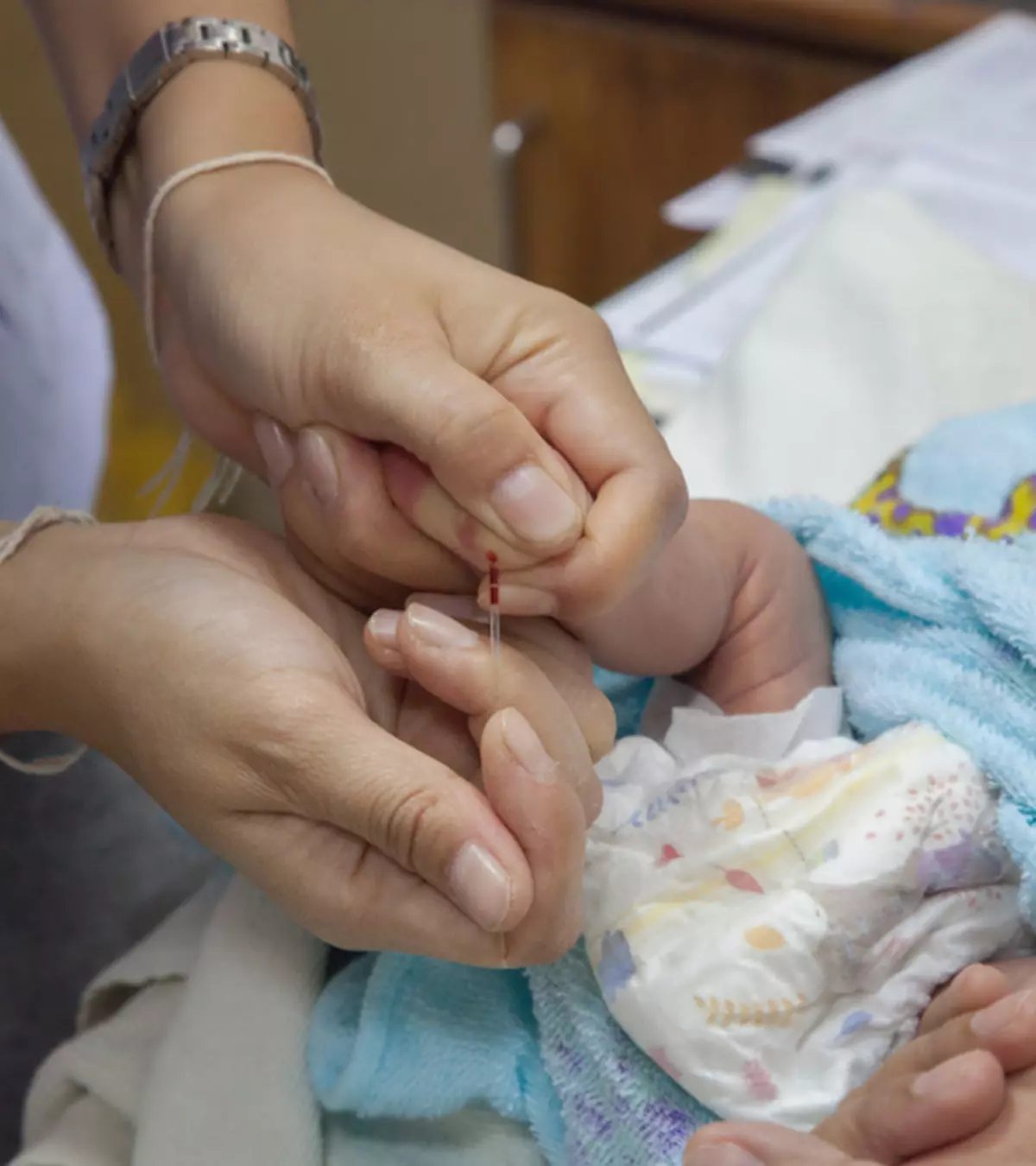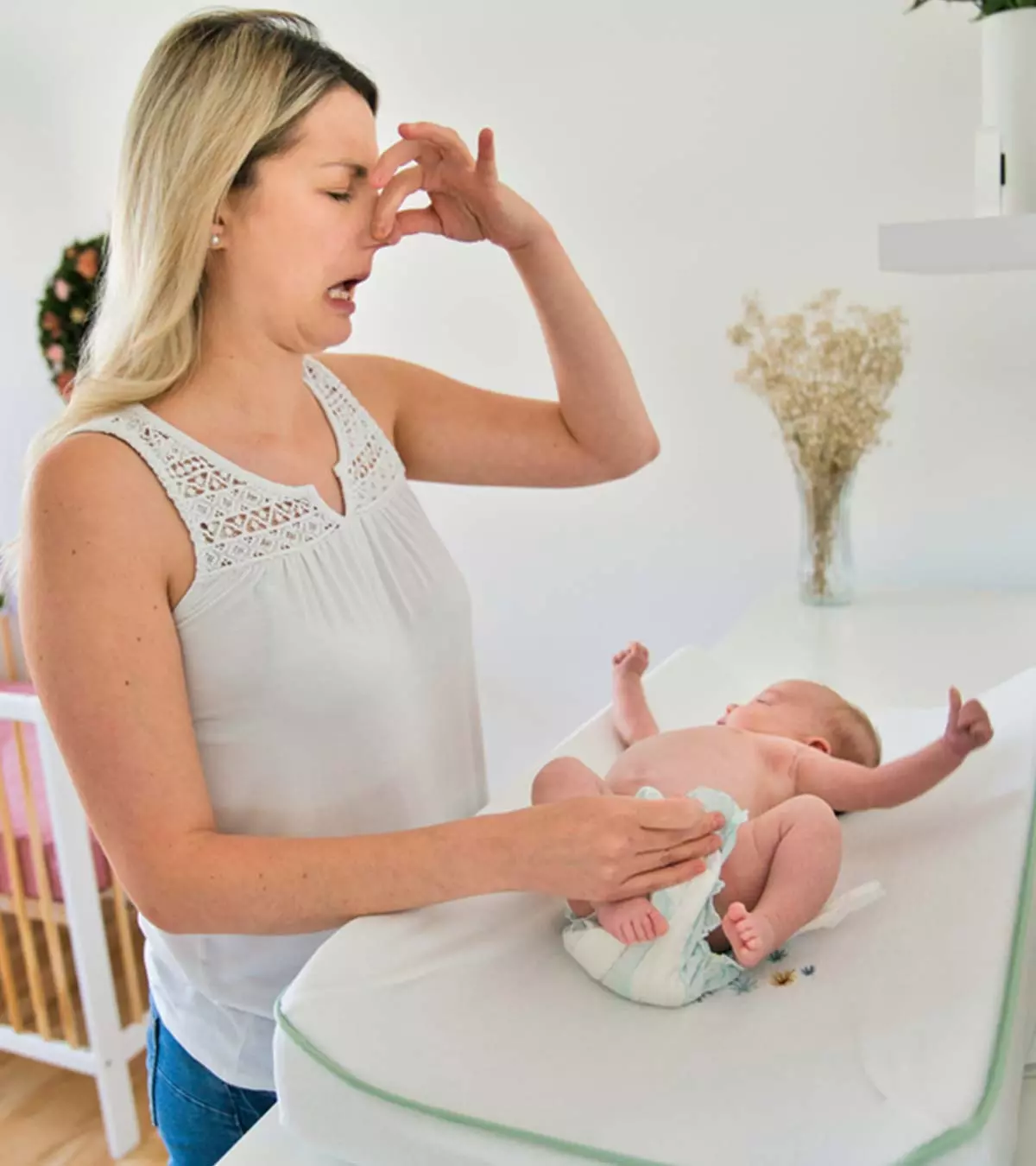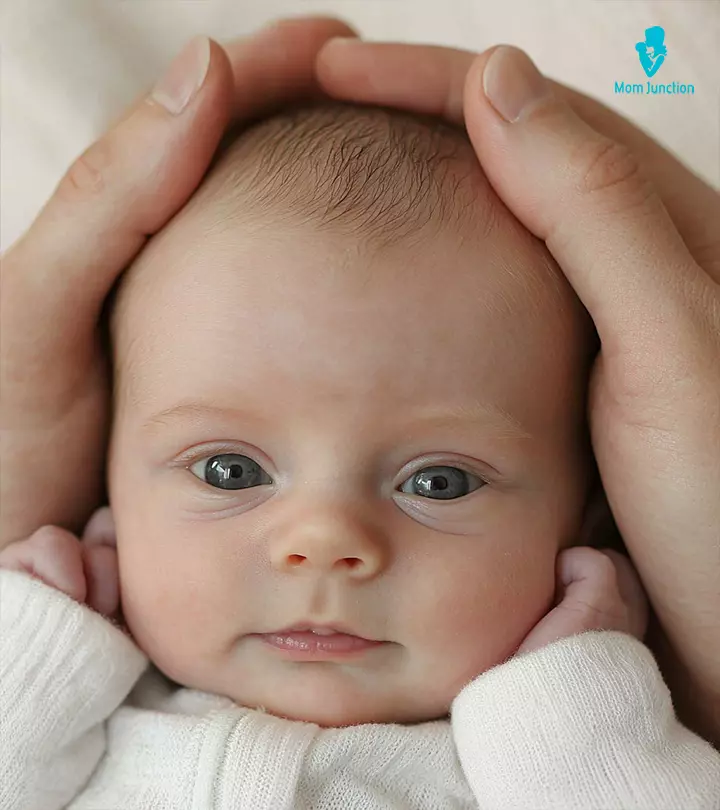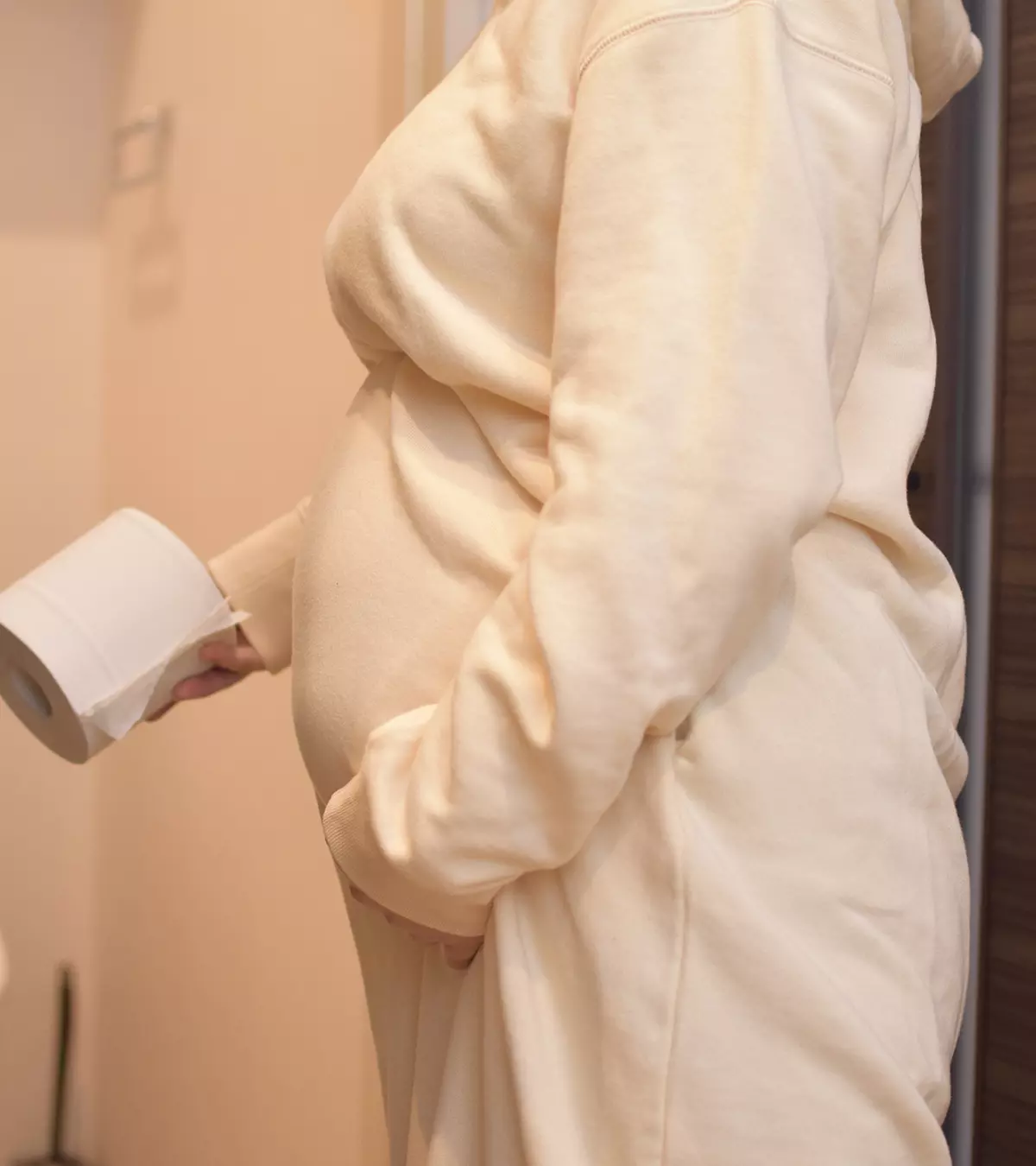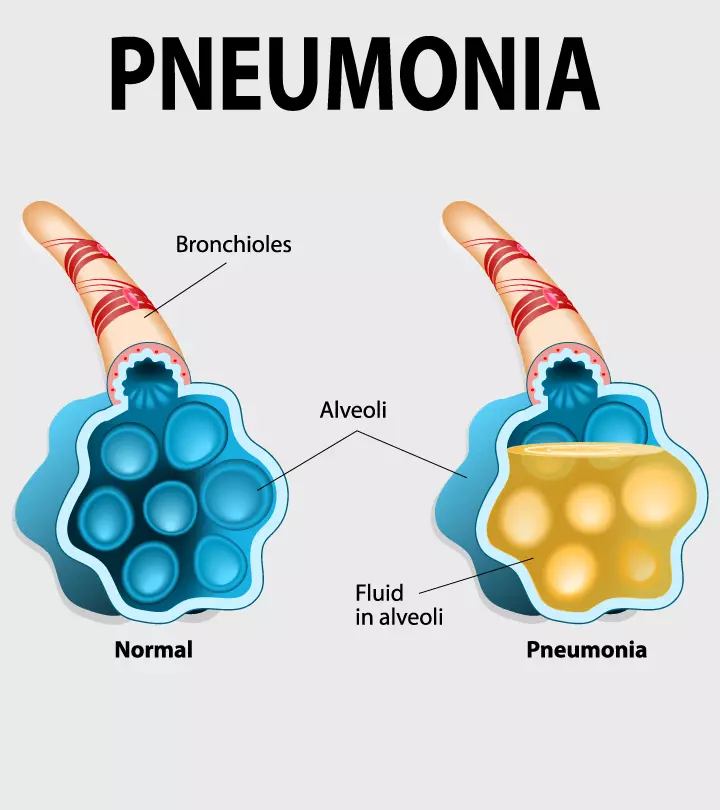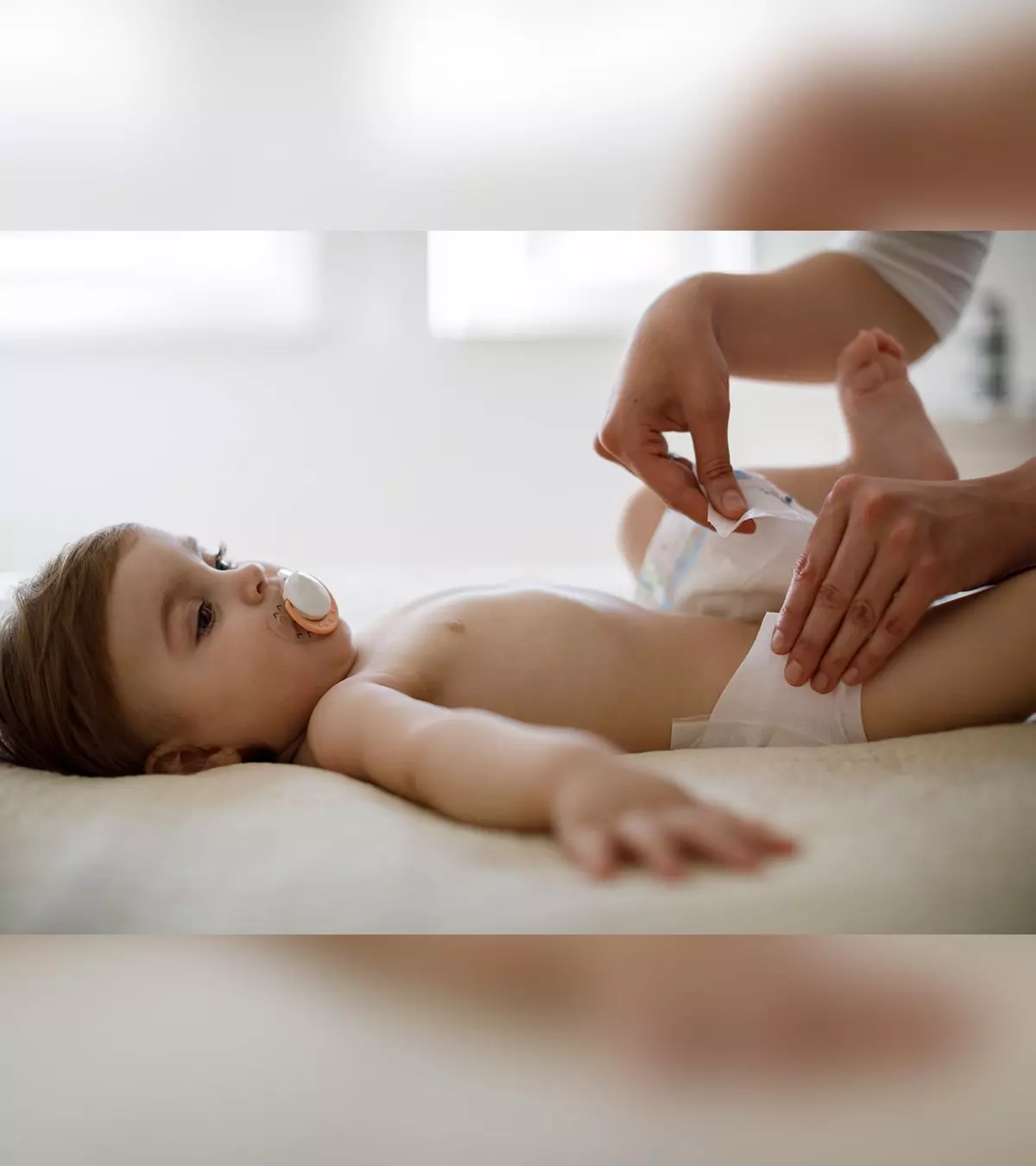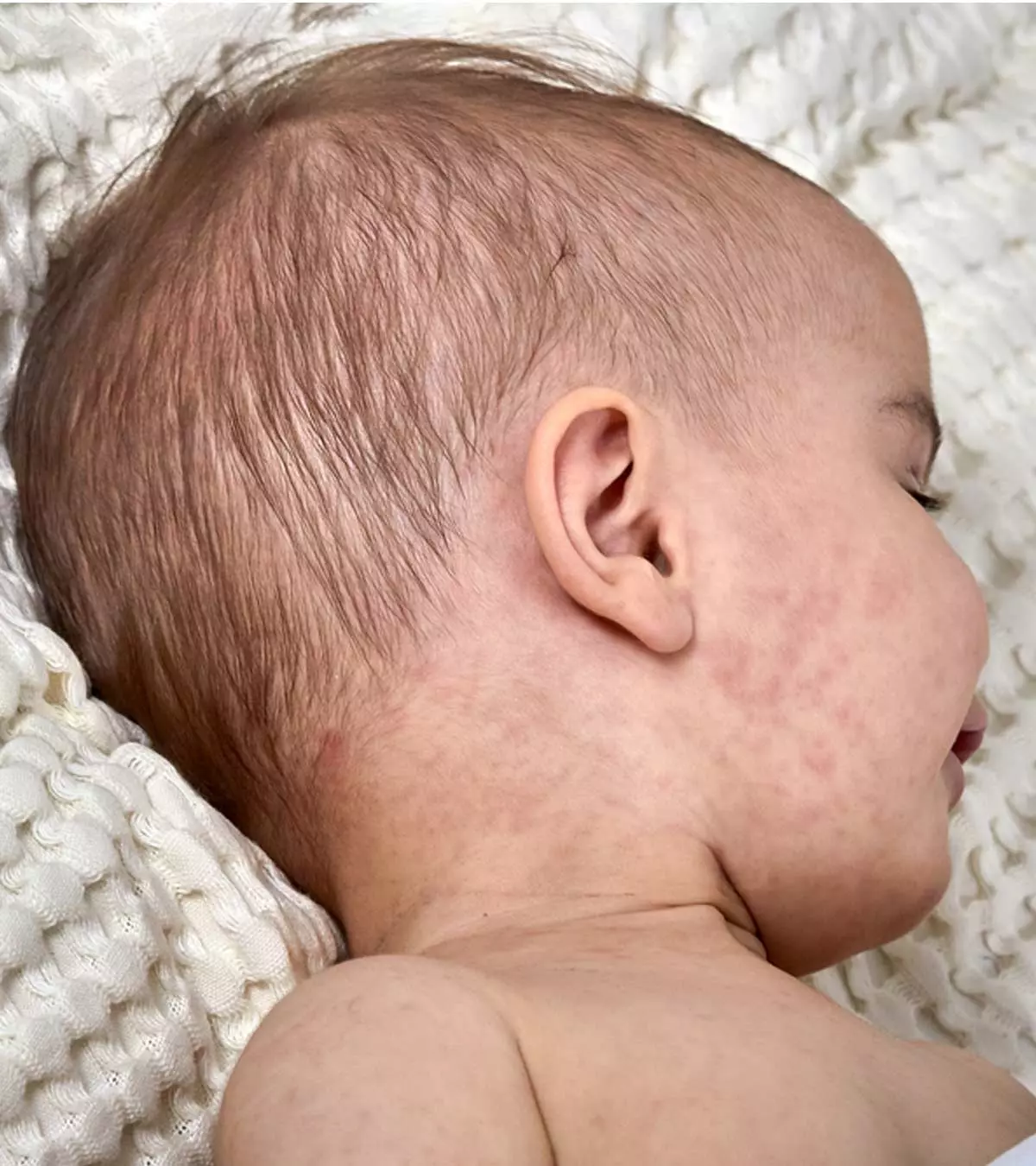
Image: Shutterstock
Viral rashes in babies may include spots, vesicles, bumps, pimples, or blisters. The type of rash may vary depending on the underlying viral infection. The rashes may disappear in a few days or last up to several weeks.

Antibiotics meant for treating bacterial infections cannot treat viral infections. Therefore, they are ineffective in reducing viral rashes. It is essential to consult a pediatrician if your baby has skin rashes to avoid severe symptoms and complications.
Understanding viral rashes in babies is important for parents. Recognizing symptoms early can help manage discomfort and prevent complications. Keep reading this post to learn more about common types of viral rashes in babies and how to treat and prevent them.
Key Pointers
- Roseola, measles, chickenpox, hand-foot-and-mouth disease, etc., are some viral infections that may cause rashes on a baby’s body.
- Some of these viral rashes may be contagious.
- Pediatricians diagnose viral rashes based on the clinical appearance and symptoms of the child.
Types Of Viral Rashes In Babies
, a board-certified pediatrician and breastfeeding specialist from Westchester, Illinois, says, “Viral rashes in babies are common and not problematic, though there are some that could indicate a problem. Babies and children commonly develop rashes due to how their immune systems react to the virus. So, a virus that does not typically cause a classic rash may cause a nonspecific rash like little red bumps or blotches. These rashes, though sometimes itchy, are benign and go away on their own.”
Viral rashes in babies can be of various types, depending on the virus that caused the infection. Observing the type of skin rashes and other symptoms and signs could help the doctors diagnose viral illnesses.
The following baby rash types with pictures help one to promptly understand the symptoms and consult a doctor (1).
1. Roseola
The skin rash in roseola is spotty, red, and flat. It is non itchy. Usually, the roseola rash begins on the belly and spreads to other parts of the body. Viral rash during roseola often appears after the fever goes away. The rash may persist for a few hours to two days.
Skin rashes in roseola
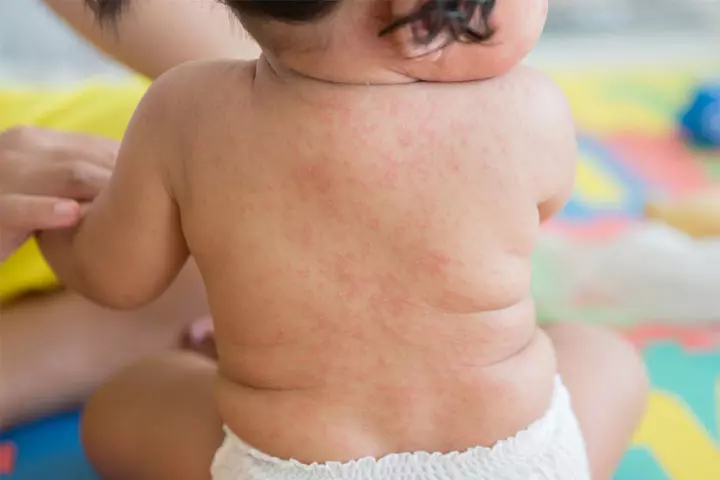
The skin rash in roseola can be a rose-colored with tiny spots. Usually, the roseola rash begins on the belly and spreads to other parts of the body. Viral rash during roseola often appears after the fever goes away.
Other symptoms and signs
- High fever, usually sudden in onset and lasting three to five days
- Runny nose, sore throat, stomach upset are seen in a few cases
- Enlargement of lymph nodesiTiny, bean-shaped organs spread throughout the body and promote a healthy immune system at the back of the head, sides of the neck and behind the ears
In some cases, the baby may also experience febrile seizures, which are brief and do not cause long-term harm. These seizures in babies are typically triggered by a rapid rise in body temperature. Once the fever subsides, the risk of seizure decreases.
 Point to consider
Point to considerHigh fever can be the cause of febrile seizuresiUncontrollable body movements or behaviors triggered by a high fever of above 100.4°F in babies. Diagnosis is usually clinical and treatment is directed towards symptomatic relief as like with most of the other viral infections roseola is taken care of by the body’s immune system.
2. Measles
According to the World Health Organization, there were approximately 128,000 measles deaths globally in 2025. These deaths were most prevalent among the unvaccinated or under-vaccinated children under the age of 5 years. Measles, or rubeola, is a highly contagious viral infection caused by the rubeola virus. This is a respiratory virus that can quickly spread from one person to another through airborne droplets. It is contagious for several days both before and after the appearance of the rash. However, this disease is no longer a common cause of viral illness in babies due to vaccinations. Babies who are not vaccinated against measles can get the disease.
Skin rashes in measles
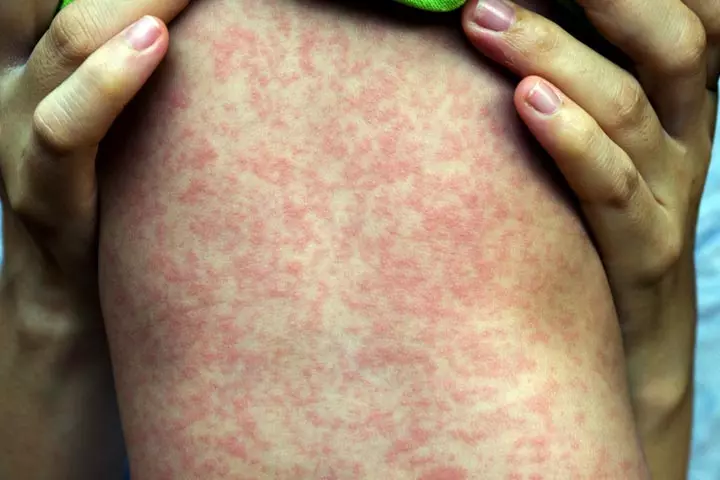
Measles rashes may develop after three to five days from the onset of other symptoms. Rashes can be red, flat spots along the hairline initially, and later on, the spots may become raised, itchy bumps. You may notice the spread of rash down the body.
Other symptoms of measles
- Stuffy or runny nose
- High fever
- Red and watery eyes
- Hacking cough
Infection may provide lifelong immunity for the survivors. However, measles may result in serious complications including brain damage or fatalities in quite a few cases. Also the immune system is weakened post measles infection, which may lead to severe bacterial infections like pneumonia. An attack of measles adversely affects the nutritional status of the child and may even lead to malnutrition due to complications like chronic diarrhoea.
If measles infection occurs, treatment is directed towards symptomatic relief and complication management.
Vaccination is the best way to avoid measles.
3. Chickenpox
Varicella-zoster virus (also known as herpesvirus 3) causes chickenpox (varicella) infection. Chickenpox has become less common due to availability of vaccine against it.
Skin rash in chickenpox
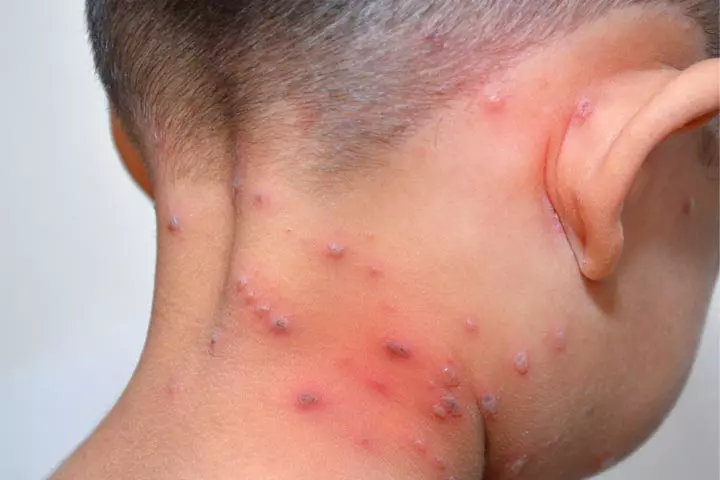
Before the rash appears children usually have moderate fever, loss of appetite, and a general feeling of illness. You may notice raised red bumps (papules), initially on the trunk and face, and it may often break out on the arms and legs in a few days. Usually, within a day, the papules may become small fluid-filled vesicles or blisters. The vesicles often cause itching, and babies may try to scratch them. Crusts and scabs appear after the vesicles break, and it usually takes several days to heal. Also, characteristically in chickenpox, the rash develops in crops so that spots are seen in different stages of development in different areas. When they are scratched, there is a risk of infection which may rarely become severe such as cellulitisiA bacterial skin disease that makes the infected area of the skin red, swollen, and painful .
Many children also have associated oral ulcersiSores that arise in the soft tissue lining of the gums, tongue, inner cheeks, or lips , even rectal and vaginal ulcersiTiny, itchy sores on the outer area of the vagina caused by germs, viruses, or sexually transmitted diseases . New spots usually stop appearing by the fifth day, the majority are crusted by the sixth day and most disappear in less than 20 days. The blisters tend to leave a scar only when they are scratched.
Other signs and symptoms
- Fever
- Headache
- Lack of appetite
- Tiredness
 Experts says
Experts saysChickenpox may last up to a week in most cases. It can be prevented in babies by routine vaccination as per an immunization scheduler. Parents who were neither vaccinated nor had a chickenpox infection should get immunized, as well.
4. Hand, foot, and mouth disease
Hand, foot, and mouth disease (HFMD) is a viral disease due to enterovirus (coxsackievirus).
This usually affects children under five years of age. However, older children and adults can also get this disease.
Skin rash in hand, foot, and mouth disease

The rash affects the skin of hands and feet and sometimes arms, upper legs, buttocks. or genitals and less commonly face and trunk. Painful sores develop on the mucosa of the mouth and throat.
Other signs and symptoms
- Fever
- Mouth sores (blisters in the mouth)
- Sore throat
- Lack of appetite
- Irritability
Mild symptoms mostly last up to a week to ten days. Treatment focuses on symptomatic relief. There is currently no vaccine to prevent hand, foot, and mouth disease in babies.
The infection can spread by bodily contact, through droplets, from feces, through contaminated objects and surfaces. It is recommended to practice adequate hygiene measures to avoid the illness.
Tiffany, a mother of two children, shares how her daughter’s Hand, Foot, and Mouth Disease (HFMD) went undiagnosed initially. She recounts, “On the 2nd day of her fever, I noticed that she started to develop some red rash around her mouth. I initially thought this was just some sort of allergy. I suspected that maybe her mouth was not wiped clean after her meals which could have caused the rash. I later noticed that the rash looked like chicken pox sores. It sort of had blisters and she kept on scratching them so I knew they were a little bit itchy.
“I then remembered that a couple of my friends mentioned their kids having Hand, Foot, and Mouth disease (HFMD) last year. They said it was like chicken pox but isolated on the hands, feet, and mouth. They also mentioned the kids getting fever for a short time prior to the rash. I checked Dawn’s hands and feet as soon as I suspected HFMD. And true enough, she had one red spot on her right hand (i).”
5. Fifth disease
The fifth disease, also called erythema infectiosum, is a viral illness due to parvovirus B19. Although the infection is common in children, they usually remain asymptomatic or have mild illness. Children with weakened immune systems or red cell disorders like sickle cell anemiaiA genetic condition where the red blood cells have an unusual crescent shape and affect the body's regular blood flow may have severe disease if the bone marrow is affected. Rarely infection in pregnant women leads to stillbirth or swelling of the fetus (hydrops).
Skin rash in the fifth disease
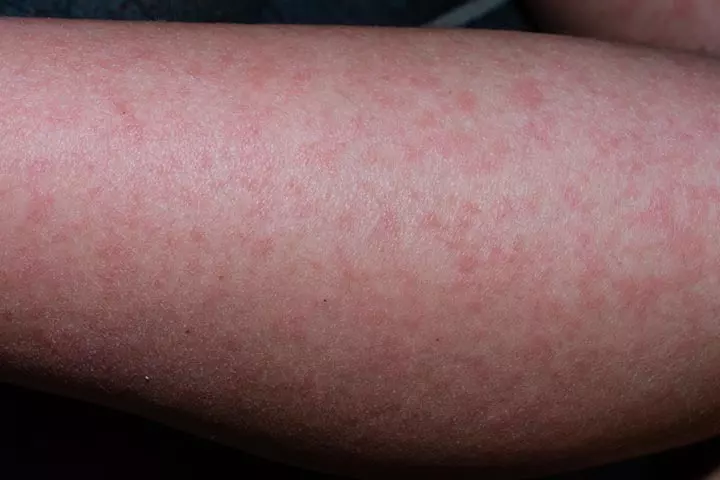
Skin rash may develop after other symptoms are cleared in the fifth disease. Baby’s cheeks may turn red as if slapped, thus the disease is also called slapped cheek disease. Skin rash may have a lacy or net-like appearance while spreading or resolving. The rash may spread to arms, legs, and trunks but never to palms and soles before resolving. The rash is worsened on exposure to sunlight. Adolescents may suffer from mild joint pain which comes and goes for several weeks post infection.
Other signs and symptoms
- Mild fever
- Stuffy or runny nose
- Fatigue
- Headache
 Point to consider
Point to considerThe infection is contagious before the rashes appear. Most children recover from the fifth disease without any long-term complications. Treatment is therefore symptomatic for management of fever and itching.
6. Rubella
Rubella, also called German measles or three-day measles, is caused by the rubella virus. Although this can be a mild infection in most people, it can cause an outbreak and can be devastating for unborn babies if mothers get an infection during pregnancy. Congenital rubella may cause cataractiAn eye condition where the eye lens becomes hazy, resulting in unclear vision , heart defects, developmental issues, and hearing loss (deafness) in newborns.
Skin rashes in rubella

You may notice a red rash or pinkish spotted rash on the face and roof of the mouth or other parts of the body. Rashes may merge and may appear like a more extensive rash. Babies may try to scratch the rashes since it can cause itching.
 Quick fact
Quick factOther symptoms and signs
- Low fever
- Runny nose
- Eye redness
- Cough
- Swollen lymph nodes on the neck, especially behind the ears
Sometimes, rubella infections can be asymptomatic. Most infected people spread the virus to others before and after the appearance of the skin rashes. Treatment is symptomatic. Once infection occurs it provides lifelong immunity. Vaccination helps protect from rubella.
Are Viral Rashes Contagious?
Some of the viral rashes can be contagious, which means that direct contact with the fluids from the rashes could spread the infection. However, most viral infections in children are spread from mucus and saliva via direct contact or airborne droplets expelled by an infected person.
Although viral illnesses are contagious, the contagious period may vary for each virus. Viral spread may happen certain days before, during, or after the appearance of the skin rash.
The contagious periods for the common viral infections in babies are the following.
| Illness | Contagious period |
|---|---|
| Roseola | Most contagious during fever.Once the fever is gone for 24 hours, it is no longer contagious,even if the rash is present (2). |
| Rubella | One week before the appearance of the rash. It continues to be contagious for seven days after the disappearance of the rash (3). |
| Chickenpox | One to two days before the rash and until all rashes are crusted. In case of a vaccinated baby,until no new rash appears for 24 hours(4). |
| Fifth disease | Contagious during fever or cold and not after the appearance of the rash (5). |
| Rubeola | Four days before and four days after the rash (6) . |
| Hand, foot, and mouth disease | Most contagious during the first week of illness. Infection may spread up to one week after the symptoms resolve (7). |
Contagious periods may vary in individual cases and depend on other factors, such as compromised immunity.
Diagnosis Of Viral Rashes In Babies
Pediatricians can diagnose a viral rash in children by observing the rash and the history of signs and symptoms. Doctors may also ask for the health history and vaccination details of the baby for diagnosis.
Although it is rare, blood tests, imaging tests, or other evaluations are ordered for confirming the diagnosis. These additional tests may also help identify any possible complications of viral rash in babies.
Treatment For Viral Rashes In Babies
Viral rashes may resolve on their own without any treatment in most cases. If symptoms worsen or new ones appear, seeing a pediatrician for advice is vital. The following treatments are often given to reduce the severity, duration, and complications of illness in babies (8).
- Pain relievers, such as acetaminophen,can be given
- Give plenty of fluids or breastmilk
- Encourage more rest
- Use ointments, creams, or lotions, such as calamine lotion, as per doctor’s recommendation to soothe itching
- Bathe baby in lukewarm water with mild soap
- Avoid scrubbing baby skin; pat dry instead
- Keep the child’s nails cut
- Use loose-fitting dresses
- IV fluids and antivirals are given in severe cases
 Quick fact
Quick factIf your baby tries to itch the rash, it is better to cover the rash to avoid secondary bacterial infections due to scratching. Antibiotics are not effective against viral rashes, and you should avoid giving them to the babies without prescription.
Prevention Of Viral Rashes In Babies
It may not always be possible to prevent exposure to viruses. However, the following precautions may reduce the risk of contracting viral illness in babies.
- Observe routine vaccinations for babies as per the recommendations.
- Caregivers, parents, or anyone who is handling babies should maintain good hand hygiene.
- Do not cough or sneeze near babies. You may cover your mouth and nose while coughing or use a mask during respiratory illnesses.
- Ensure there is adequate good hygiene at the baby’s daycare facility.
- Keep the child away from others, such as siblings and family members, with viral rashes.
Frequently Asked Questions
1. How do I know if my baby’s rash is serious?
If the skin rashes are accompanied by fever, swollen glands, cough, or cold, seek prompt medical attention. Even if the other symptoms do not accompany the rash, it is safe to consult a doctor to know the cause and receive treatment (9).
2. How can I stop a viral rash from spreading?
To prevent a virus from spreading, ensure your baby is given the prescribed medication on time, apply any given ointments, wipe the house surfaces and the common touch points and wash your hands frequently. If your baby is eligible for vaccinations, ensure they receive the suggested doses (10).
3. How long does a viral infection last in a baby?
Dr. Rubin opines, “Most viral infections and rashes in babies last up to five days and then slowly resolve over a week. However, rashes associated with lethargy, pain, persistent fever, and loss of appetite or those that show no signs of improvement after a week should be examined by a physician.”
Viral rashes in babies may sometimes be accompanied by fever, runny nose, upset stomach, and sore throat. The contagious period may vary from one infection to another, and it is recommended to keep them at home for that period to avoid spreading the illness. Viral rashes usually resolve without treatment, but babies born prematurely or with compromised immunity may need medical care. Prevent your child from scratching the rashes. Check with a doctor for proper diagnosis and medications such as pain relievers and topical ointments or creams to soothe the rashes.
Infographic: When To Seek Medical Attention For Viral Rash In Babies?
It is important to evaluate viral rashes in babies to determine the virus causing it. Most viral rashes are self-limiting and often go away without complications. However, rashes caused by some viral illnesses need medical care. Go through the infographic to know when to seek medical care based on the symptoms and signs accompanying the rashes.
Some thing wrong with infographic shortcode. please verify shortcode syntax
Understand how to diagnose rashes in children by watching this helpful video. Learn how to recognize common skin issues in children and the best ways to treat them.
Personal Experience: Source
MomJunction articles include first-hand experiences to provide you with better insights through real-life narratives. Here are the sources of personal accounts referenced in this article.
i. Our experience with hand, foot, and mouth disease (HFMD).https://densandfan.blogspot.com/2013/07/our-experience-with-hand-foot-and-mouth.html
References
1. Viral Exanthems (Rashes); Children’s National Hospital
2. Roseola; St. Clair Hospital
3. About Rubella; The Centers for Disease Control and Prevention
4. About Chickenpox; The Centers for Disease Control and Prevention
5. Fifth Disease; Commonwealth of Massachusetts
6. How Measles Spreads; The Centers for Disease Control and Prevention
7. HFMD: Causes and How It Spreads; The Centers for Disease Control and Prevention
8. Viral Rash (Child); Fairview
9. Serious Childhood Rashes; Pregnancybirth & baby
10. Viral Exanthem Rash; Cleveland Clinic
11. Roseola – Viral Rash; Seattle Children’s Hospital12. How To Care For A Child With Chickenpox; American Academy Of Dermatology13. Fifth Disease (Erythema Infentiosusm);; Nationwide Children’s Hospital
14. Rubella In Newborns; MSD Manual
15. Viral Exanthems (Rashes);; Children’s National Hospital
Community Experiences
Join the conversation and become a part of our nurturing community! Share your stories, experiences, and insights to connect with fellow parents.
Read full bio of Dr. Pooja Parikh

Dr. Cindy Rubin is a pediatrician and breastfeeding medicine specialist practicing in the Western Suburbs of Chicago. She did her undergrad at Stanford University, medical school at Georgetown, and pediatrics residency at the University of Chicago. After working at Loyola University Medical Center as an outpatient general pediatrician for 13 years, she opened her new practice, In Touch Pediatrics and Lactation.
Dr. Cindy Rubin is a pediatrician and breastfeeding medicine specialist practicing in the Western Suburbs of Chicago. She did her undergrad at Stanford University, medical school at Georgetown, and pediatrics residency at the University of Chicago. After working at Loyola University Medical Center as an outpatient general pediatrician for 13 years, she opened her new practice, In Touch Pediatrics and Lactation.
Read full bio of Dr Bisny T. Joseph
Read full bio of Rohit Garoo
Read full bio of Shinta Liz Sunny











